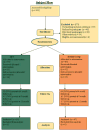Malaise, motivation and motherhood: predictors of engagement in behavioral interventions from a randomized controlled trial for HIV+ women in drug abuse recovery
- PMID: 20512409
- PMCID: PMC3051343
- DOI: 10.1007/s10461-010-9714-z
Malaise, motivation and motherhood: predictors of engagement in behavioral interventions from a randomized controlled trial for HIV+ women in drug abuse recovery
Abstract
Drug abuse has serious consequences for the wellbeing of persons with HIV/AIDS but suboptimal rates of client engagement limit the efficacy of interventions. The present study examines and compares client characteristics that predicted engagement (defined as attendance at two or more sessions) in a family intervention (SET) and a group intervention within a randomized trial aimed at preventing relapse and improving medication adherence for 126 predominantly African American HIV+ women in drug abuse recovery. Intervention engagement (60% overall) was not significantly different across the two interventions. Fewer physical and mental symptoms (malaise) (P < 0.05), living independently (P < 0.05), living with children (P < 0.05), and readiness to change (P < 0.05) were associated with engagement across the two interventions. Results from this study can be used to inform outreach and engagement approaches for women dually affected by drug abuse and HIV/AIDS.
Figures
Similar articles
-
Relational factors and family treatment engagement among low-income, HIV-positive African American mothers.Fam Process. 2003 Spring;42(1):31-45. doi: 10.1111/j.1545-5300.2003.00031.x. Fam Process. 2003. PMID: 12698597 Free PMC article.
-
Predictors of medication adherence in high risk youth of color living with HIV.J Pediatr Psychol. 2010 Jul;35(6):593-601. doi: 10.1093/jpepsy/jsp080. Epub 2009 Sep 15. J Pediatr Psychol. 2010. PMID: 19755495 Free PMC article. Clinical Trial.
-
A randomized controlled trial of Structural Ecosystems Therapy for HIV medication adherence and substance abuse relapse prevention.Drug Alcohol Depend. 2010 Oct 1;111(3):227-34. doi: 10.1016/j.drugalcdep.2010.04.017. Epub 2010 Jun 9. Drug Alcohol Depend. 2010. PMID: 20538417 Free PMC article. Clinical Trial.
-
Social and structural determinants of HIV treatment and care among black women living with HIV infection: a systematic review: 2005-2016.AIDS Care. 2018 Apr;30(4):409-416. doi: 10.1080/09540121.2018.1426827. Epub 2018 Jan 28. AIDS Care. 2018. PMID: 29376409 Free PMC article.
-
Parenting and child outcomes of HIV-infected African American mothers: a literature review.J Community Health Nurs. 2013;30(3):164-71. doi: 10.1080/07370016.2013.806704. J Community Health Nurs. 2013. PMID: 23879582 Review.
Cited by
-
A Mental Health-Physical Health-Violence (MPV) Syndemic Factor in Women with Mental Disorders.Stigma Health. 2019 Nov;4(4):383-390. doi: 10.1037/sah0000152. Epub 2018 Sep 27. Stigma Health. 2019. PMID: 33094162 Free PMC article.
-
Motherhood and Treatment Outcome in Female Patients with Compulsive Buying-Shopping Disorder.Int J Environ Res Public Health. 2022 Jun 9;19(12):7075. doi: 10.3390/ijerph19127075. Int J Environ Res Public Health. 2022. PMID: 35742322 Free PMC article.
-
Health Correlates of Abuse History and Moderating Effect of Parenting Stress for Mothers with Mental Disorders.Issues Ment Health Nurs. 2021 Jun;42(6):555-563. doi: 10.1080/01612840.2020.1820121. Epub 2020 Sep 23. Issues Ment Health Nurs. 2021. PMID: 32965137 Free PMC article.
-
Finding what works: Predicting health or social service linkage in drug using, African American, female sex workers in Miami, FL.Health Care Women Int. 2016 Jul;37(7):744-59. doi: 10.1080/07399332.2016.1158262. Epub 2016 Mar 2. Health Care Women Int. 2016. PMID: 26933839 Free PMC article. Clinical Trial.
-
Social Support and Coping Strategies in Patients with Traumatic Brachial Plexus Injury.HSS J. 2020 Dec;16(Suppl 2):468-474. doi: 10.1007/s11420-020-09814-z. Epub 2020 Nov 4. HSS J. 2020. PMID: 33380981 Free PMC article.
References
-
- Klinkenberg WD, Sacks S, HIV/AIDS Treatment, Adherence, and Health Outcomes and Cost Study Group Mental disorders and drug abuse in persons living with HIV/AIDS. AIDS Care. 2004;16:S22–42. - PubMed
-
- Lucas GM, Cheever LW, Chaisson RE, Moore RD. Detrimental effects of continued illicit drug use on the treatment of HIV-1 infection. J Acquir Immune Defic Syndr. 2001;27:251–9. - PubMed
-
- Sherbourne C, Forge NG, Kung FY, Orlando M, Tucker J. Personal and psychosocial characteristics associated with psychiatric conditions among women with human immunodeficiency virus. Womens Health Issues. 2003;13:104–10. - PubMed
-
- Calsyn RJ, Klinkenberg WD, Morse GA, Miller J, Cruthis R, HIV/AIDS Treatment, Adherence, Health Outcomes and Cost Study Group Recruitment, engagement, and retention of people living with HIV and co-occurring mental health and substance use disorders. AIDS Care. 2004;16:S56–70. - PubMed
-
- Compton WM, Glantz M, Delany P. Addiction as a chronic illness—putting the concept into action. Eval Program Plan. 2003;26:353–4.
Publication types
MeSH terms
Grants and funding
LinkOut - more resources
Full Text Sources
Medical



